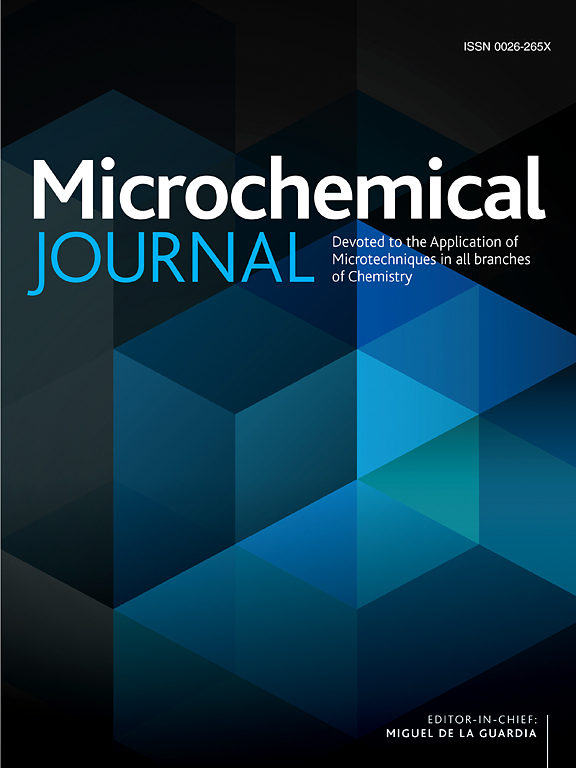Development of method for SARS-CoV-2 spike protein determination in saliva samples at fg mL−1 levels using electrochemically controlled preconcentration and molecularly imprinted polypyrrole sensor
IF 4.9
2区 化学
Q1 CHEMISTRY, ANALYTICAL
引用次数: 0
Abstract
The present study describes a novel approach for designing a highly sensitive and selective electrochemical sensor for the detection of SARS-CoV-2 in saliva samples by sensing the S-protein, using an electrochemically controlled preconcentration. The sensor is based on electropolymerized molecularly imprinted polypyrrole (PPy) onto a screen-printed carbon electrode (MIP/PPy). The morphology of the MIP/PPy sensor was evaluated by SEM and AFM. The selectivity of the MIP/PPy compared to NIP/PPy was assessed by rebinding S-protein, followed by the monitoring of the redox probe ([Fe(CN)6]3−/4−). A substantial decrease in the anodic peak current of the redox probe was noticed when using the MIP/PPy. The detectability of the sensor was greatly improved (c.a 1,000,000 fold) by using controlled electrochemical preconcentration of S-protein at +0.6 V for 1.0 min in the rebinding process. Under this condition, a low limit of detection of 6.8fg mL−1 and an analytical curve in the range of 50.0–125.0 fg mL−1 (R2 = 0.996) was obtained. The reproducibility for 10 authentic sensors was highly satisfactory with a relative standard deviation (%,RSD) of 2.8 %. Upon preparation, the sensor can be stored for up to 14 days under refrigeration, with a response efficiency greater than 85 %. The MIP/PPy exhibited high selectivity toward S-protein compared to antitrypsin, human serum albumin (HAS), transferrin, HIgG, and lysozyme. The sensor was applied for detecting SARS-CoV-2 virus through S-protein in infected patients’ saliva samples and validated by RT-PCR. In addition, the satisfactory recovery (91 to 103 %) in S-protein spiked negative samples attested to the free-interference analysis.

用电化学控制预富集和分子印迹聚吡咯传感器测定唾液样品中fg mL - 1水平的SARS-CoV-2刺突蛋白方法的建立
本研究描述了一种新的方法,设计了一种高灵敏度和选择性的电化学传感器,通过电化学控制的预浓缩,通过传感s蛋白来检测唾液样本中的SARS-CoV-2。该传感器基于电聚合分子印迹聚吡咯(PPy)到丝网印刷碳电极(MIP/PPy)上。利用扫描电镜和原子力显微镜对MIP/PPy传感器的形貌进行了表征。与NIP/PPy相比,MIP/PPy的选择性通过重新结合s蛋白来评估,然后监测氧化还原探针([Fe(CN)6]3−/4−)。当使用MIP/PPy时,氧化还原探针的阳极峰值电流显着降低。在s蛋白重结合过程中,在+0.6 V下控制s蛋白的电化学预富集1.0 min,传感器的检测能力大大提高(约100万倍)。在此条件下,检测下限为6.8fg mL−1,分析曲线在50.0 ~ 125.0 fg mL−1范围内(R2 = 0.996)。10个真实传感器的重现性非常令人满意,相对标准偏差(%,RSD)为2.8%。制备完成后,传感器可在冷藏条件下保存长达14天,响应效率大于85%。与抗胰蛋白酶、人血清白蛋白(HAS)、转铁蛋白、HIgG和溶菌酶相比,MIP/PPy对s蛋白具有较高的选择性。将该传感器应用于感染患者唾液样本中s蛋白检测SARS-CoV-2病毒,并进行RT-PCR验证。此外,s蛋白加标阴性样品的回收率(91% ~ 103%)令人满意,证明了无干扰分析的有效性。
本文章由计算机程序翻译,如有差异,请以英文原文为准。
求助全文
约1分钟内获得全文
求助全文
来源期刊

Microchemical Journal
化学-分析化学
CiteScore
8.70
自引率
8.30%
发文量
1131
审稿时长
1.9 months
期刊介绍:
The Microchemical Journal is a peer reviewed journal devoted to all aspects and phases of analytical chemistry and chemical analysis. The Microchemical Journal publishes articles which are at the forefront of modern analytical chemistry and cover innovations in the techniques to the finest possible limits. This includes fundamental aspects, instrumentation, new developments, innovative and novel methods and applications including environmental and clinical field.
Traditional classical analytical methods such as spectrophotometry and titrimetry as well as established instrumentation methods such as flame and graphite furnace atomic absorption spectrometry, gas chromatography, and modified glassy or carbon electrode electrochemical methods will be considered, provided they show significant improvements and novelty compared to the established methods.
 求助内容:
求助内容: 应助结果提醒方式:
应助结果提醒方式:


